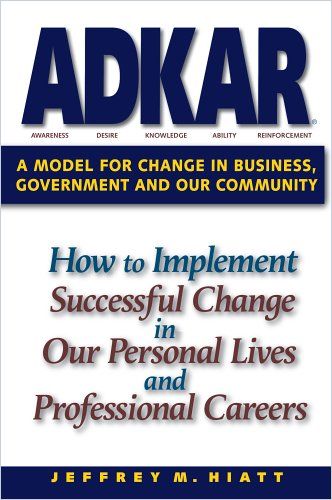Jeffrey M. Hiatt offers his well-regarded, step-by-step guide to successful change initiatives fueled by enthusiastic employee participation.

Effective Change Initiatives
Creating awareness about why a change is necessary is the best fuel for any effective change initiative, says change-management expert Jeffrey M. Hiatt. He details the five building blocks – “awareness, desire, knowledge, ability and reinforcement” – of the ADKAR change-management strategy. Hundreds of organizations use this method to bring about transformative change.
Hiatt’s great strength is the clarity of this presentation. Leaders well-versed in change initiatives may already know that they’ll find a welcome superstructure here. New leaders or those running start-ups facing grow-driven change will welcome Hiatt’s simplicity, straightforwardness and focus on results.
ADKAR
The ADKAR model, Hiatt explains, focuses on people’s reactions to change and establishes a logical, step-by-step sequence. Hiatt offers ADKAR to leaders managing change, from small projects to giant initiatives for larger organizations.
All of our change initiatives would have gone great if it weren’t for all the people involved.Jeffrey M. Hiatt
He also recommends the ADKAR model for diagnosing why change initiatives didn’t work and for implementing more effective strategies for future initiatives. Hiatt endorses ADKAR not only for managing corporate change, but also for education, coaching, evaluation and strategizing.
Awareness
Awareness concerns the internal and external drivers that prompt a change; an aware employee wants to know how he or she will benefit – or suffer – from a change initiative.
In a 2005 study with 411 companies undergoing major change projects, the number one reason for resistance to change was lack of awareness of why the change was being made.Jeffrey M. Hiatt
Communicate with your employees to build awareness of the need for change while staying cognizant of each person’s understanding of his or her current position. Consider how each employee perceives problems, how much credibility each employee gives to the person who is presenting the change initiative, how rumors might spread and how employees might contest the company’s reasons for pursuing change.
To build awareness, Hiatt recommends creating materials that clearly state the business rationale for the change. He tells leaders to stand firm regarding the change, to give employees all the necessary information about the change and to explain precisely how it will affect them and the company. He also suggests assisting managers in becoming skilled coaches.
Desire
Desire concerns the voluntary acceptance of the change initiative, getting behind it and participating in it. People, the author reminds you, want understand any change to determine why they should support and accept it – that is, to develop their motivation.
In the absence of desire, no amount of knowledge can produce change.Jeffrey M. Hiatt
Diagnose the factors that may de-motivate people and assess your firm’s expectations. Hiatt notes that employees want to know what’s in it for them. He emphasizes that person-to-person success depends on each employee’s family situation, money, physical stamina, personal relationships, education, mobility and track record at work.
Hiatt suggests creating a coalition of managers and executives who champion the change initiative, showing them how to become strong change leaders and teaching them how to deal with resistance to change. To help marshal employee support, make sure your incentive programs align with the change initiative.
Knowledge
Each employee needs the right instruction and information. People may need to learn specific new job skills, methods, procedures and tools to implement the change. Employee background knowledge is a crucial factor in any change initiative. Hiatt urges evaluating how well your employees can learn and determining if you have the funding, teachers, materials and facilities to educate them as necessary. Ensure, too, that your employees have access to the data they need – and if not, conduct research and call in experts to obtain it.
The author explains that to develop the knowledge needed to make your change initiative successful, you must create training programs, provide one-on-one coaching, and set up user groups to explore the change initiative’s problems and solutions.
Ability and Expertise
Executing a change program requires transforming knowledge and information into hands-on action. Assess each person’s ability and capacity and diagnose what obstacles might interfere with successful implementation.
ADKAR provides a goal-oriented framework that helps change leaders realize their objectives more quickly and completely.Jeffrey M. Hiatt
Hiatt understands that people’s psychological blocks, physical abilities, intellectual capacities, learning time capacity and the availability of resources to spur development of their new abilities all factor into the future of any change initiative. To help improve your employees’ ability, get their supervisors involved. Organize a change-initiative training program, make sure those who need expert assistance can access relevant experts and monitor everyone’s performance.
Reinforcement
Change initiatives require internal and external reinforcement of the factors that deliver change. Hiatt identifies organized celebration of any successful step in a change process as “external reinforcement.” Rewarding the work of a change team member is “internal reinforcement.”
Change is reinforced when recognition and rewards are meaningful to an individual.Jeffrey M. Hiatt
To reinforce change, Hiatt recommends holding employees accountable for change, publicly celebrating success, securing employee feedback, conducting change-initiative audits, uncovering the reasons for any flawed change-program adoption and instituting corrective measures.
ADKAR Life Cycle
ADKAR unfolds in a specific order because each element builds on the one before. Desire can’t precede awareness because no one wants what they don’t know about. Knowledge cannot precede desire because no one wants to learn about something if they don’t care about it. Ability, Hiatt underscores, can’t precede knowledge because everyone needs know-how to implement change. And reinforcement can’t precede ability because company recognition applies only to ongoing achievement.
Focus on the Individual
ADKAR’s components focus on individual employees, particularly on preparing them for your change initiative. Thus, Hiatt implicitly and explicitly reminds leaders that company-wide, blanket change initiatives do not work. Every initiative’s success depends on each individual employee’s response to – and embrace of – the initiative. For all of Hiatt’s detailed information about how to apply ADKAR, that might be his most valuable and applicable lesson.
Jeffrey M. Hiatt also wrote the Employee’s Survival Guide to Change and co-wrote Change Management with Timothy J. Creasey. Other worthwhile books on change include the very accessible Leading Change and Our Iceberg Is Melting by John P. Kotter.





